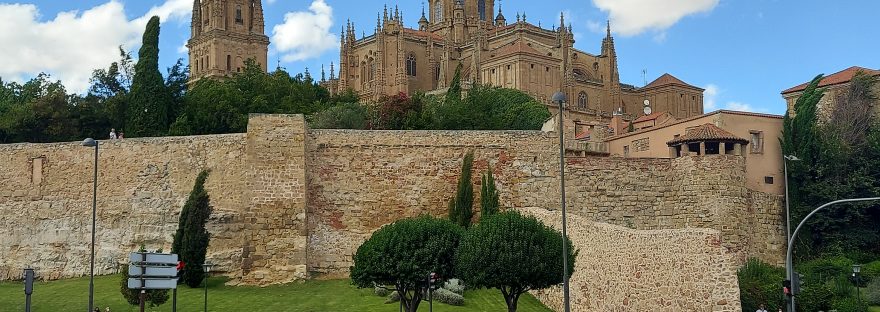In 1491, the Cabildo of Salamanca proposed the need for a temple of larger dimensions, since the Old Cathedral, Romanesque, was small and dark for the time, given the population development that was taking place at that time. The master builders of the cathedrals of Toledo and Seville were hired, with the mission to build a new cathedral for Salamanca, laying the first stone on May 12, 1513. We had commented in the previous article dedicated to the Old Cathedral, that when we observe the structure it gives the impression that it is only one cathedral and not two. This was achieved by supporting the New Cathedral on the north wall of the Old Cathedral. The wall was reinforced towards the interior of the old temple, leaving the lateral nave partially reduced with the new construction. The tower of the new cathedral was built over the bell tower of the Old Cathedral. Continue reading “The New Cathedral of Salamanca”
Category: “Salamanca”
Old Cathedral of Salamanca
Six cities in Spain have two cathedrals and Salamanca is one of them. Some of these are built separately and others, as in the case of the cathedrals of Salamanca, may be united. The reality is that, for nearly four hundred years, the Old Cathedral and the New Cathedral have lived together as one. And, although they may appear to be a single structure, the truth is that each has its own separate history and so we will treat them as such. For obvious reasons, it is with the Old Cathedral of Salamanca that we begin the first part of this article. Continue reading “Old Cathedral of Salamanca”
The Stairway to Heaven of the “Clerecía” of Salamanca
Of baroque style, the Clerecía is the name given to the building of the former Royal College of the Holy Spirit of the Society of Jesus, built in Salamanca between the XVII and XVIII centuries. This building, which today houses the Pontifical University of Salamanca, was begun in 1617, by order of Queen Margaret of Austria and Philip III. Its objective was to be the main center for the formation of the Jesuits who would later be sent to the American colonies and the Protestant countries of central Europe. Later, after the expulsion of the Jesuits from Spain, the building passed to the Real Clerecía de San Marcos, hence the abbreviation Clerecía. Subsequently, the Clerecía ceded the building (except for the church) to the Diocese of Salamanca, which installed the Seminary of San Carlos. Continue reading “The Stairway to Heaven of the “Clerecía” of Salamanca”
Saint Stephen’s Convent
 When one thinks of the Spanish city of Salamanca, one thinks of everything related to education, specifically theology, geography and law. Its medieval buildings were witnesses to a golden age, where illustrious characters who contributed and changed the rhythm of history strolled about.
When one thinks of the Spanish city of Salamanca, one thinks of everything related to education, specifically theology, geography and law. Its medieval buildings were witnesses to a golden age, where illustrious characters who contributed and changed the rhythm of history strolled about.
The “Salina” Palace
 When visiting the Spanish city of Salamanca, a visit to the Palacio de la Salina is a must. Although only the courtyard is open to the public and can be visited, it is worth it. Continue reading “The “Salina” Palace”
When visiting the Spanish city of Salamanca, a visit to the Palacio de la Salina is a must. Although only the courtyard is open to the public and can be visited, it is worth it. Continue reading “The “Salina” Palace”





